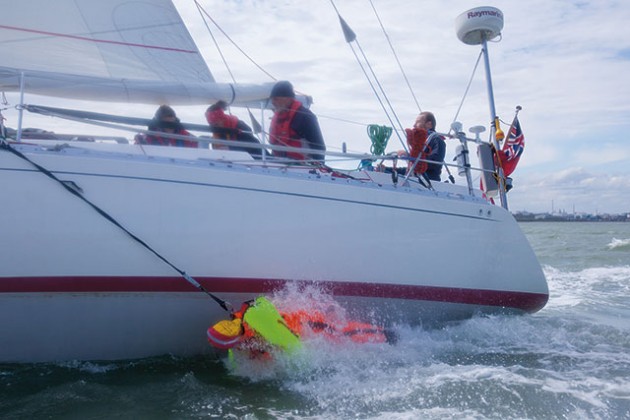
The Protections and Perils of Tethering Yourself Into a Sailboat
During a recent discussion about lifejackets, many of our readers said that in addition to a PFD, tethers were an essential piece of offshore equipment. There is no question that tethers are both widely used and a basic, no-brainer method of keeping sailors attached to the boat. But tethering, like every safety measure, brings with it a perception of security that may be shattered if the unthinkable occurs.
In the case of tethering, one is inevitably going to be dragged with the boat. Depending on where you fall and how long the tether is, this may represent different degrees of protection or peril.
In 2015, Practical Boat Owner tested tethers to demonstrate the practical effects of going into the drink while clipped in. The trials produced “sobering results.”
PBO referenced a 2011 accident where a skipper perished after going overboard off southern England. A subsequent investigation found that the sailor had done “everything by the book. He was wearing a lifejacket and he was clipped on with a tether, or safety, line — but when he went overboard from the foredeck on a dark night, he was dead by the time the crew could recover him.”
To test tethering, PBO dragged ‘Fred’, a “realistic, weighted rescue dummy wearing a lifejacket” off a boat, using tethers of various lengths, sailing at various speeds, and placing the dummy on both the windward and leeward sides of the boat. Using a long tether, “Fred dangled close to the hull on the windward side. His position was in the trough of the boat’s quarterwave, and he was repeatedly smashed into the hull by the waves. On the leeward side the long tether allowed him to be swept back into the boat’s boiling quarter-wake; he was almost entirely submerged, with the lifejacket unable to keep his head out of the water.”
A short tether on the windward side kept the dummy out of the water; on the leeward side, the shorter length put the dummy in the boat’s gurgling wake. The length of the tether is one of those pesky compromises between safety and comfort; the longer the tether, the more mobility and freedom, but the greater the risk once overboard.

On a trip down the coast in 2020 — from the Bay to the Channel Islands — we wore harnesses at night, and would clip in during the hour of solo watch, as well as whenever we left the cockpit. The skipper instructed us to attach the tether in a way that allowed for a quick release in the event that we found ourselves dragging in the water. It was a strange prospect, at once tethering yourself to the boat, but being ready to cut yourself loose.
“You need to reduce your speed to below two knots within one minute to give a tethered casualty a chance of survival,” PBO said. One minute? Even that seems like an eternity if someone is bobbing and bashing in the water.
Whenever we discuss MOB scenarios, there’s usually a lot of emphasis on the crew, their PFD, and even the color of their foul weather gear. These are all salient factors, but ultimately, it’s the crew’s ability to get back to the person who’s fallen overboard — and then to get them back on in a timely manner in all kinds of conditions — that will make the difference between life and death.
For these reasons, our readers often emphasize the need to practice MOB scenarios. But does anyone out there practice tethered MOB situations?

Single-handing with a windvane brings in new considerations. It reminds me of Olivier Huin’s statement in his Breskell documentary. “Falling over board is not allowed.”
Single-hanger Tristan Jones, who used a self-steering device, did not use a tether on passages. Instead, he towed a 100’ steering trip-line. His intent was to get to the line and trip the steering so the boat would round-up, and he could reboard. Don’t know if he ever actually had to use it – but it seems like a good idea.